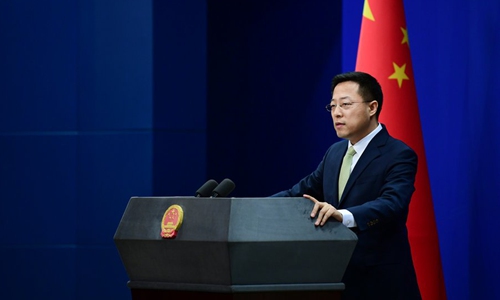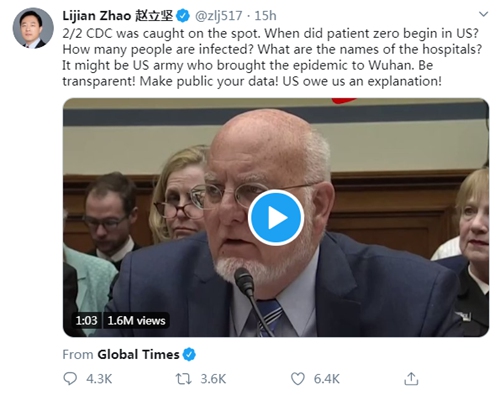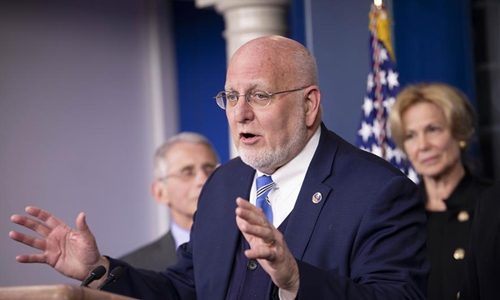US sparks word war against China on COVID-19
Outspoken diplomat suspects US as source of virus

Zhao Lijian, spokesperson of the Chinese Foreign Ministry
Screenshot of Zhao Lijian's tweet Director of the U.S. Centers for Disease Control and Prevention(CDC) Robert Redfield (front) speaks during a press conference with members of the White House coronavirus task force in the White House in Washington D.C., the United States, on March 2, 2020. CDC announced Monday that there are currently 91 cases of COVID-19 in the country, up from just 60 cases a day ago. Photo:Xinhua
Heated online discussions were sparked by the latest tweets by outspoken Chinese diplomat Zhao Lijian, who questioned the transparency of the US epidemic response mechanism, following the Trump administration's all-out campaign to smear China on its handling of the coronavirus crisis, as part of an information war embedded with racial discrimination and malicious accusations. Zhao fighting back on social media was praised by the Chinese public as a "smart move" to use the American officials' tactics against themselves.
While growing loopholes have been exposed in the US system, coronavirus-related conspiracy theories exploited by the US to shift the blame to China, seen as part of its information war engagement with the virus battle, would hinder countries from cooperating in overcoming the common enemy, analysts warned.
Chinese Foreign Ministry spokesperson Zhao Lijian claims it might be US army representatives who brought the novel coronavirus to Wuhan, Central China's Hubei Province in October 2019, after a top US health official admitted detecting coronavirus infections on some deceased flu patients. Zhao urged the US to disclose further information, exercise transparency on coronavirus cases and provide an explanation to the public.
Zhao, a famously outspoken Chinese diplomat, posted these concerns on his Twitter account, resonating with similar doubts raised by the Chinese public.
US Centers for Disease Control and Prevention head Robert Redfield told the House Oversight Committee panel Wednesday on the novel coronavirus pneumonia (COVID-19) response that some cases may have been misdiagnosed as flu that actually were infected with coronavirus, sparking heated online discussions on the flawed US system that might have seriously delayed the epidemic response, while some US politicians and media shift the blame on China.
Such misjudgment of coronavirus cases in the US, in addition to the fact that the source of the coronavirus is still unclear, raised public suspicion on whether the virus had surfaced in the US earlier, as 37,000 Americans had died from the common flu in the US in 2019.
US President Donald Trump tried to downplay the impact of the coronavirus by suggesting there are 546 confirmed cases of coronavirus with 22 deaths, while flu-related deaths averaged between 27,000 and 70,000 per year.
US CDC has been fiercely criticized by not only the American public and observers but also frontline doctors in the country, according to media reports. Some have raised questions on the US' healthcare system, which is based on market-driven principles, ignoring the fundamental interests of American people, and has ultimately become profit-oriented.

Growing loopholes
As the US COVID-19 situation becomes increasingly uncertain, the Chinese public shared the suspicion raised by Zhao that the US might be the source of the virus and that the US is subject to questioning and is obliged to explain to the world, experts said.
The US waged an information war against China, creating a buzz in their media in the early stage of outbreak in China. But when Chinese people raised reasonable doubts over the US' handling of the virus and the possibility of its misconduct in dealing with the common flu, many Americans claimed China is creating conspiracy theories, which are sarcastic, analysts said.
In the early stages of the epidemic, the US blamed China with several groundless accusations and discrimination. Now, the world sees the US as the reason for many problems while the source of the virus remains undetected, Zhang Yiwu, a cultural expert at Peking University, told the Global Times.
"Zhao has always been known for his outspoken approach in public opinion. He, as a diplomat whose rank was not particularly high in China's official system, raised the questions in his personal capacity, which is a good strategy," Zhang said.
China's governance system has always been strict and inflexible, including its diplomatic system, and the country needs officials like Zhao and the system needs both moderate and aggressive diplomats. The overall diplomacy could be flexible, Zhang added. "The West should get used to such Chinese diplomats."
Matt McCarthy, an infectious disease physician in New York, recently publicly criticized the unavailability of rapid diagnostic tests, and he deemed the insufficiency of test kits a national scandal, which could not reflect what the real situation is. Lack of testing kits also angered the public, leading to more doubts that the real numbers of infection in the country could be much higher than the reported figures.
Also, the Trump administration has been blamed by the US media and residents for weakening the officers in charge of preparing for an emergency public health crisis, as it kept cutting US CDC's budget and staff in the past two years. Trump proposed cutting the US CDC budget by $1.3 billion, nearly 20 percent below the 2019 level.
Even as the deadly virus continues to spread across the US, there are increasing signs of flaws and loopholes in the US government's response, including efforts to conceal information about the epidemic, possible failure to differentiate the coronavirus from the common flu, and attempts to shift blame on others with racist rhetoric. The role of the CDC has been weakened, and the Trump administration continues slashing the budgets of health programs with very vague details while many Americans struggle to get covered by affordable healthcare plans, especially vulnerable groups.
In early February, the White House unveiled a budget that called for massive CDC cuts. Trump is also proposing a $3 billion cut to global health programs, including a 53 percent cut to the World Health Organization, and a 75 percent cut to the Pan-American Health Organization.

The global community has been striving to battle the epidemic as well as conspiracy theories about the disease outbreaks, especially after the US constantly accused China of spreading the virus to the world and its delayed response, as well as lack of information that caused a larger scale of virus spread. And some American officials, including Secretary of State Mike Pompeo, are using "Wuhan virus" which is considered a racist term as the origin of the disease remains unknown.
China has noticed that there are discussions on the origins of the novel coronavirus pneumonia, and some US officials and congressmen made groundless accusations and attacked China, which we firmly oppose, Chinese Foreign Ministry spokesperson Geng Shuang said in response to a question on the latest tweet by Zhao.
The origins of COVID-19 are still disputed, Geng said.
"The international community has different views on the origins of COVID-19, and China always believes this is a science issue that requires scientific and professional opinions," Geng said during a routine press conference on Friday.
When asked if questions raised by Zhao represent China's official stance, Geng said the origins of COVID-19 is a question for science, which needs to be based on professional consultations - "that is the Chinese stance," he added.
Chinese officials came up with reasonable countermeasures, which are necessary, Li Haidong, a professor at Institute of International Relations of China Foreign Affairs University, told the Global Times.
However, some Western media take Zhao's personal tweets as China's stance to fuel a conspiracy theory that the US spread the virus first. "Interpreting this move of fighting back as a conspiracy is an exaggeration, deemed from America's long-standing hostile attitude toward China," Li said.
Amid the outbreaks, disinformation, even conspiracy theories, seemed to transmit even faster than the disease while major social media platforms, including Facebook and Twitter, have met with the WHO to figure out how to handle misinformation. However, the US attempt to politicize the epidemic from the beginning has accelerated the disinformation spread, inflaming a public opinion war against China, analysts said.
"The US should avoid taking epidemic matters as political purpose. But since the beginning, some US officials continuously smeared China on this topic, which is unacceptable," Li said.
Some US officials even repeated rumors on social media by suggesting the virus originated from a bio lab in Wuhan and that the first infection was reported there.
Senator Tom Cotton told an interview that the lab was near a market some scientists initially thought was a starting point for the virus's spread, the Washington Post reported.
Chinese netizens praised Zhao as his tweet was a fightback following the US' repeated accusations on China and Wuhan.
"So far, the whole world is speculating on the origins of the virus. Why is the US talking nonsense and framing China all the time, why can't we question the US?" A Weibo user named Lu Xiaozhou asked.
"In August 2019, the US virus research base was under an emergency shut down, and one month later, a deadly flu outbreak engulfed the US. Then in October, the US army participated in military games hosted in Wuhan, and soon Wuhan had the COVID-19 outbreak. It's also the US that had the five coronavirus sequencing types…" the post shared by many Chinese netizens said.
Some netizens have also voiced their doubts and noticed that Zhao used the word "might be," as this claim would need more evidence to support.
Still, Zhao's raising of a series of questions on social media echoed some suspicions of the Chinese public, and the US needs to provide a proper explanation for those giant loopholes in its epidemic response system, Chinese analysts said.